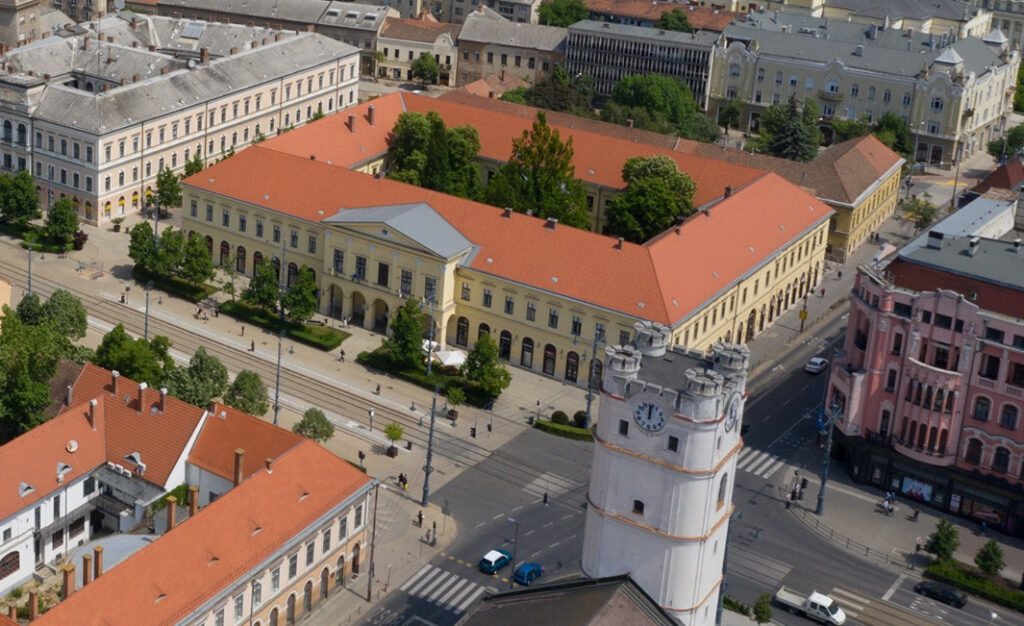The Old Town Hall (Régi Városháza) building is one of the most characteristic of the classicist architecture in Debrecen today. The site was originally bought by the city in 1531 from Judge András Tar and the first Town Hall was built upon it.
The building became one of the most important places in the city, a place where the top magistrates and the Chief Justice decided about matters of life and death. Regardless of the activities taking place there, the town hall and its operation have been characterized by frugality for centuries.
Even though the city was wealthy thanks to the income from trade and agriculture, the town hall and its operation were characterized by frugality for centuries and little was spent on “ordinary” (city-owned) houses and modernization, that is, up until the 19th century.
The Old Town Hall was “built” by expanding a single-storey residential building over the centuries. The ground floor was rented to 18-19 shops, and the town hall itself operated upstairs and in the courtyard (wing) section of the building. By the end of the 18th century, the main building and the “prison house” in the courtyard were in such a state of disrepair it was thought collapse likely. After 1802, much of the office had to be relocated to other city-owned houses when the city fire caused further damage.
Reconstruction of the Old Town Hall
The first plan of the one-storey town hall, which also reflected the rank of the city, was made by the designer of the Reformed College and the Great Church, Mihály Péchy, but nothing was done with the plan for two decades.
In 1823, the plan was discussed by the General Assembly and then the construction of the four-street, well-thought-out Town Hall, was ordered, and in the process the re-arrange of the main street of Büdös köz (Smelly street!) to Rózsa utca and to expropriate a site on Cegléd utca for the opening of the new street (Városház Street).
Construction began with the collapse of the prison building in 1825.
The street foundations of the Town Hall were prepared by Ferenc Povolny based on the chamber plans, while Peter Rachbauer built the oldest part of today’s rectangle building in 1825-1826, including the basement, the mezzanine, and the first floor. After that, the construction stopped due to a shortage of funds.

In 1834, the ancient building on the main street was ruined by an earthquake. In 1837, Povolny continued construction with a smaller section of the building, the public archive section.
At this point the extension from Városház Street to the Rózsa Street Gate had already been realized, built with a deep cellar, a ground floor, and an upstairs level connected to the existing one.
During another break in construction, in 1838, József Ságody reworked Povolny’s plans. With some modifications, the Rachbauer brothers built the missing building wings from 1839 to 1844 accordingly. This time Povolny was in charge.
The water needed for the masonry work is likely to have come from an 18th century well that still exists today in the inner courtyard.
Despite the year “1843” carved into the vault of the main entrance arcade and “MDCCCXLII” (1842) on the facade of Kossuth Street, the first general assembly was held on May 8, 1844, and construction was completed only in the fall of 1844.
The closed yard could be entered by car at the main gate on Piac Street, there were side gates on Cegléd (Kossuth) Street and Rózsa Street. The office window facing the street was barely on the ground floor, as it was rented to 18-22 shops.
The prison was on the mezzanine floor and in the basement of the City Hall wing.
Upstairs could be reached by an ornate and two side staircase, where there were offices, meeting rooms, and the mayor’s service apartment. The famous book printing house was also set up in the building.
The command center of the war of independence in 1848-1849
In the first half of 1849, the town hall played a prominent role in the history of Debrecen and Hungary. The city gave accommodation and offices to the government that fled Pest. In 1849, Lajos Kossuth lived in the building with his family, and the office of the Defense Committee was also here. The Holy Crown also took refuge here. The governor and his family lived on the main street floor in the area facing the Great Church, while the iron chest of the royal relics was hidden at the other end of the upstairs corridor, in a secret archive room facing Kossuth Street.
Recent changes
At the end of the 19th century, the mezzanine level of the prison was transformed into offices. A spacious restaurant and a large printing hall were set up in the basement. The open arcades upstairs have been replaced by a row of windows. At that time, the gate on Rózsa Street was also walled in for office purposes.
In 1916, a bridge was built over the Városháza street to connect the Town Hall with the adjoining trading house, which had been transformed into an office.
After 1950, some of the business premises also became offices. The huge hall of the basement, where the former printing house was located, was turned into the rehearsal room of the folk dance ensemble and then into a microfilm technology center.